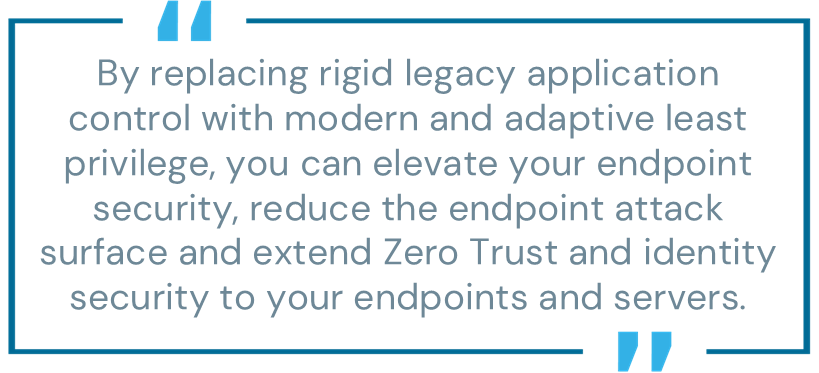
When attackers gain access to a single endpoint—like a developer’s workstation or an HR system—it’s often game over. With some skill and patience, that foothold can escalate into full-blown disruption: stolen data, operational downtime, and brand damage.
For years, technologies like application control have served as the frontline defense against this. But in a world rife with rapid change and evolving threats, traditional approaches are showing their age.
Legacy application control is resource-heavy, rigid, and increasingly out of step with how organizations operate. Moving from the grind of basic application control to a least privilege model marks a critical shift in endpoint security strategy—not just in security posture but also in efficiency, scalability, and simplicity.
Application control: what it gets right (and where it falls short)
For years, application control has been a mainstay of endpoint protection. It’s often praised for being lightweight yet highly effective, blocking a maximum number of threats with minimal overhead and computational power.
At its core, the concept is simple: control what can run on an endpoint through:
- allowlists (permitting specific applications)
- denylists (blocking known threats)
- A combination of both
This straightforward approach has historically proven helpful in reducing the attack surface. But in practice, traditional application control comes with significant limitations:
- Lack of flexibility: Traditional application controls can’t adapt to fast-changing environments like developer machines or businesses undergoing rapid transformation. The result? Bottlenecks and frustrated users.
- Management overload: Policies need constant updating, troubleshooting is reactive, and IT teams are stretched thin.
- Missing user identity context: Application control doesn’t track who is running what, making it harder to detect insider threats or credential misuse.
- Limited threat coverage: Even with strong allowlisting and denylisting, application control proves less effective against advanced persistent threats (APTs) or misuse of legitimate applications, which exploit privileges that applications inherently have.
While still valuable for static environments, relying on application control as a standalone security mechanism has drawbacks in a fast-paced, hybrid-first world.
What is the least privilege principle?
The principle of least privilege (PoLP) is simple but powerful: Users, applications, and processes should have only the exact permissions they need to perform their roles or tasks—nothing more. By removing unnecessary permissions, PoLP shuts down overprovisioning, limits lateral movement, and reduces the blast radius of any attack, whether it comes from inside or out.
Unlike rigid application control, least privilege is flexible and intelligent, adjusting in real time to fit user behavior, context, and evolving needs.
Why organizations are making the switch to least privilege enforcement
Transitioning to a least privilege strategy can help to substantially reduce the attack surface by restricting access rights to only what is necessary for users and devices to perform their tasks. This approach minimizes the risk of insider threats, complicates lateral movement, limits the impact of compromised accounts, and enhances overall security posture.
Paired with enhanced security for privileged accounts, such as password rotation on use, and continuous user identity assurance, these layers present a formidable challenge to most threat actors.
1. Enhanced security posture
Eliminating unnecessary privileges and isolating risky applications can significantly shrink the attack surface. This approach helps block common pathways for ransomware, insider threats, and lateral movement within networks. Identity-based controls also reduce the usability of techniques associated with stolen credentials or compromised accounts.
2. Improved operational efficiency
A properly implemented (using the right tools and right frameworks) least privilege approach can help automate administrative tasks that were previously manual, such as policy enforcement and privilege removal. Advanced analytics can give security teams insights to make informed decisions without micromanaging every application or user interaction. Additionally, self-service workflows (like just-in-time (JIT) privilege elevation) can help end users work uninterrupted, reducing IT ticket volumes.
3. Simplified compliance
Maintaining and demonstrating compliance can be daunting for organizations governed by regulations like PCI-DSS or NIST SP 800-53. Applying a least privilege solution helps introduce identity context and automate foundational compliance measures, such as enforcing least privilege and maintaining audit trails of user actions. With real time monitoring and comprehensive reporting, businesses can showcase compliance on demand, reducing the burden of audits.
4. Cost reduction
Solutions utilizing least privilege can help lower costs in multiple ways. IT teams spend less time managing security policies, incidents, and audits, while streamlined user workflows boost productivity. By addressing security gaps, organizations can also reduce potential costs associated with breaches, such as downtime, ransom payments, or legal penalties. Most cyber insurers also require intelligent privilege controls, and implementing least privilege and user Identity assurance can help reduce Insurance premiums.

Real-world considerations before getting started with least privilege
Transitioning to least privilege takes planning, but the right approach makes it achievable. Here are key steps to keep in mind:
- Gain visibility first: Use rapid risk reduction and least privilege frameworks to deploy discovery policies that will provide visibility into application usage patterns. These insights help identify the specific privileges each user or process truly needs.
- Define least privilege application policies and remove local admin rights: This helps prevent bypassing the security controls and circumventing the security measures, including application control.
- Use automation wherever possible: Solutions that utilize the least privilege approach can offer built-in templates, workflows and AI assistants to simplify setup and ongoing management.
- Implement ringfencing: Impose selected restrictions on any application not matched by a least privilege policy (also called greylisting) to help automatically reduce the attack surface even further.
For example, a ringfenced ransomware sample would be restricted from accessing:- The Internet—preventing registration with a command-and-control (C&C) server and download of encryption keys
- The Intranet—preventing scraping and encryption of sensitive data on network shares
- The memory of other processes—preventing password dumping or exploitation of other apps
- The Windows registry—preventing reconfiguration of the OS or third-party applications
- Educate end users: While least privilege implementations usually reduce or completely remove friction associated with running applications as administrators, it can also change workflows. Clear communication and training can help users understand the importance of these changes and go a long way in building buy-in.
- Integrate with your stack: Modern solutions that integrate seamlessly with IT service management (ITSM) platforms, security Information and event management (SIEM) tools for monitoring, and third-party identity providers can help enable automated or semi-automated workflows and build a defense-in-depth security strategy. A solution built on these principles can help protect and capitalize on your investments in cybersecurity.
Least privilege brings app control into the identity era
The emergence of endpoint identity security reflects a broader trend in cybersecurity—shifting from reactive, perimeter-focused defenses to proactive, identity-first security strategies. By replacing rigid legacy application control with modern and adaptive least privilege, you can elevate your overall endpoint security strategy, reduce the endpoint attack surface and extend Zero Trust and identity security to your endpoints and servers.
A comprehensive identity-based approach to endpoint protection can help to secure every human identity from the moment they log in to their machine, throughout their day as they work with native and SaaS applications and continue protecting their identity after they log out.
Allison Senatore is a product marketing manager at CyberArk.























